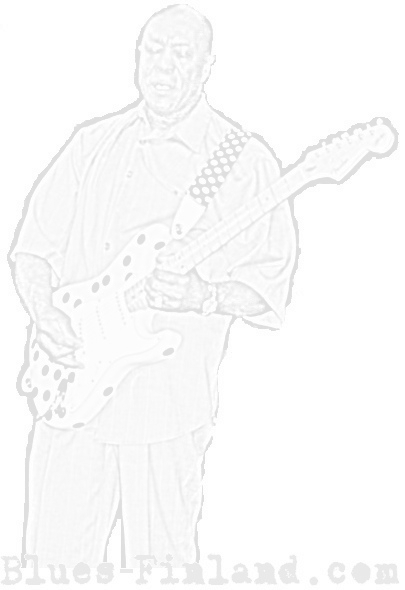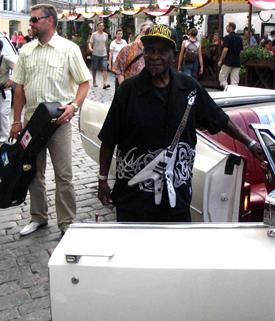 |
| Contact: admin (a) blues-finland.com © 2007 Blues-Finland.com |
| Mississippi Heat: Honeyboy Hits Tallinn 24 August 2007 Photo gallery As David “Honeyboy” Edwards’ plane lands in Tallinn around noon on August 8th, the temperature reaches a highly uncharacteristic +34 degrees C. After a brief wait, the airport doors open and a big fellow decked in airport uniform appears, pushing a wheelchair that seems filled with a huge guitar case with “Honeyboy” scrawled across it in block letters. Then something moves in the chair, and we meet the piercing gaze of two unusually alert eyes peering out from underneath a baseball cap. Strangely out of place in the Euro-standard arrivals hall of the sleepy Soviet-built airport, those dark eyes could hardly belong to a 92-year-old - or could they? “Mr. Edwards?” A bright smile flashes and a loose, wiry hand is extended: “Yeah…” |
 |
| In a second, we are joined by a long-haired American in purple plastic shoes. Carrying a number of suitcases and another guitar, Earwig Records bossman Michael Robert Frank escorts his meal ticket to the car. At the hotel, the Pittsburgh-born Frank proceeds to enjoy the wonders of air-conditioning while our veteran Mississippi Delta bluesman orders it switched off in his room and grabs a harmonica – he says he needs a little rest after the flight from Copenhagen where he’d played a 75-minute set the night before. VIP in Clazz As the evening nears, journalists gather at the Clazz restaurant in the centre of the 13th century Old Town: photographers and reporters from dailies and online tabloids, the Spanish editor of Helsinki’s Free! Magazine, and even a TV crew from Estonian National Broadcasting. “You’re a very important person here,” Michael Frank whispers into Honeyboy’s ear as the legendary bluesman emerges from a white Cadillac convertible. The wheelchair is gone, and so are Frank’s purple shoes; with a press conference and a 2x45-minute show ahead, the gentlemen obviously mean business. Answers to almost all question asked at the press conference have been well-documented for a decade, but their neglected homework aside, the press seem genuinely respectful. Honeyboy dutifully reports that the first record he remembers hearing was “Sittin’ On Top Of the World” by the Mississippi Sheiks in 1929, “and that was a good number”; Frank announces a new Honeyboy Edwards album to be released in October, featuring selected guests like Bobby Rush on harmonica. Incidentally, the album available at the Tallinn shows is 1997’s “The World Don't Owe Me Nothing” with the late great Carey Bell. Not even yours truly dares to ask how come Honeyboy’s official website credits him as the author of the Robert Johnson/Kokomo Arnold classic “Sweet Home Chicago”, and just as well. Honeyboy takes us from Mississippi to Chicago, from Maxwell Street to Beale, introducing everyone from Little Walter to B.B. King along the way, and as he does so, the years on his shoulders seem to roll off by the dozen. When asked about his current heavy touring schedule, he just shruggs: “I probably will slow down some but I don’t believe I can really quit. I don’t know how to quit, ‘cause that’s all I know to do, and I like it sometimes myself - I used to love it when I was young, but I like it now!” Eventually, of course, someone was bound to come up with the infamous Robert Johnson question, and someone does. Honeyboy pauses briefly, and takes us back to Mississippi, one more time. On Robert Johnson “Well the night we was there at Three Fork, ah… Robert had played out there for this man about 7 or 8 months. Me and Sonny Boy no. 2 was the only musicians who was out there the night when he got poisoned. And ah, what happened… Robert started goin’ with the man’s wife, you know, and he lived in this little town called Greenwood, Mississippi – that’s where I went to school at. She had a sister lived right there, and every Monday morning she had to go see her sister, but she was goin’ to see Robert. Somebody went told her husband, that’s how he got caught, so… “When me and Sonny Boy got out there twelve o’clock, Robert’s sittin’ in the corner with his guitar, bottle of corn whiskey down there, he had drunk about half of it down. People comin’ in, want him to play: “Play the “Terraplane Blues”, play the “Kind Hearted Woman Blues”!” “You try to play,” he says, “I’m sick here, I don’t feel good!” But everybody knowed him and they just thought that he’d drunk so much whiskey, he just need another drink, they said: “Take another drink, you’ll be alright!” “Still, he wasn’t alright. They brought him back to this little town where we stayed at, Greenwood, and that was Sunday morning. He died on a Wednesday, the 16th day of August, 1938. He died on a Wednesday, and they buried him on a Wednesday. His sister come from Chicago on a Thursday and dug him up and put him in a casket and put it back in the ground the next day. So that’s how it was, I was there all the way through – I been around a long time…” Rollin’ & Tumblin’ And that’s that. The reporters withdraw temporarily and a waitress approaches Honeyboy: “Can I get you something to drink, a glass of water perhaps?” The elderly gentleman looks up in amazement: “Can I get a BEER?” A few moments later, Messr's. Frank and Edwards are fondly reminiscing about some “white whiskey” they’d been offered at a Kentucky festival not so long ago, looking around with questioning eyes. Promptly, two prominent Tallinn musicians make arrangements for smuggling them a taste of local homebrew in time for next night’s show. One can’t heIp thinking Jack Kerouac was right: you can’t teach the old maestro a new tune. Minutes earlier, Honeyboy's story of the first-ever gig he’d played when he was 13 had ended with the following: “I come in next Sunday morning, and I was drunk. My father sittin’ on the steps, I looked at my father, he looked up at me, said: “Hey, boy.” I said “He-e-e-y Daddy! I’m so drunk I can’t hear rooster crow for day!”" But unlike in the version heard in Martin Scorsese's 2004 documentary "Lightning In a Bottle", he hadn’t stopped there: "So from then on, I got the taste of the whiskey then – that whiskey started tastin' good...!” At a quarter to nine, Bullfrog Brown takes the stage for a brief opening set. There are no stage monitors, but that’s neither a surprise nor a problem; we reckon that after 79 years in the business, Honeyboy won’t care either. It’s less fun for the audience, though, as half the crowd is seated before TV screens in adjoining rooms, and the house PA is only a very slight improvement on a portable stereo. The photographers had been asked not to use flash, but it hadn't occurred to anyone that they might insist on using camera tripods in these cramped quarters; as it is, they effectively block the stage from everybody's view. There's no air-conditioning in the club, and beer tastes good. Honeyboy walks on with his heavy metal-looking BC Rich guitar and takes off with “Catfish Blues”, accompanied by Michael Frank on harmonica. The sound is rough, conveying an air of sustained aggression; the heat in the club is as intense as the music, and as soon as the local celebrities voicing their tabloid opinions at the bar have left, the transformation is complete. Tonight, the Mississippi runs across the Town Hall Square. Rollercoaster Ride As the two men leave the stage, Michael Frank approaches me: "Honeyboy wants you guys to join him when he comes back." I say: "!" First, however, Bullfrog Brown does another brief set; we are joined by Finland's harmonica wizard Harry "Dirty Dawg" Finér, and it’s fun - we haven't seen Harry since we first met seven years earlier on our way to the Augustibluus festival in Haapsalu. Then Honeyboy and Frank come up, and we're off. In a moment, I recall everything I've ever read about Muddy Waters' delay singing - and indeed, the only way to follow Honeyboy is to close one’s eyes and focus on his vocals. The chord changes only come when a line is really finished, with extra bars and half-bars popping up all over the place. Even then, there's no telling which chord will follow: it might go straight to V or revert back to I, there might be three turnarounds or none at all... The photographers have been removed from the front row and it is now filled with young and pretty girls. The effect on Honeyboy is instant: the way his allegedly arthritic fingers dance on the fretboard and the wild gestures he makes with his picking hand bring to mind the surviving video footage of Lightnin' Hopkins, particularly the Texan’s 1970's flashy electric performances. Come to think of it, he too was playing to a young audience and having fun trying to shake the band; and didn't Honeyboy just say he'd changed his style in 1951 when he "went out in Texas"...? Earlier, Michael Frank had told me that even after 35 years with the man, he still doesn't play on all songs. So when at the start of another number he suddenly jumps up and throws the harmonica mic to Harry, it doesn't come as a big surprise; however, the uptempo jazz number that follows leaves me gaping and smiling as I watch a man being rejuvenated before my very eyes - there's no way for me to keep up with those chord and tempo changes and chaotic stops. But Harry rides it out in style, although the look of genuine bewilderment never quite leaves his face. "Michael Frank must have known the trouble he was getting me into - I had introduced myself to him as a harpist in case they needed one, not knowing he was Honeyboy's harmonica player. Revenge?!" Finér laughs a few days later. "Frank was standing next to me, laughing and instructing me to "lay back". Which is when I understood why he himself plays the way he does, using long notes and vibrato, always slightly behind..." One Chord To Kill a Man As it turns out, we got off easy. The night before in Copenhagen, Honeyboy had tuned his electric guitar to F instead of E without telling Frank; consequently and on the grounds that the batteries in Honeyboy's electric tuner were running low, I was asked to tune Honeyboy's electric for the first show in Tallinn. Evidently, Mr. Edwards needed no help and no tuner for setting up his other guitar, an acoustic tuned to "Spanish" or open G, and on the next night, August 9th, he did all of his tuning by himself. One of the people jamming with him then was Estonia’s finest blues guitarist, Raul Ukareda of Compromise Blue. Obviously thrilled with the experience, he bursts out laughing when I ask him about it a week later: "Well it wasn't easy! I just wish someone had told me Honeyboy tunes down to Eb instead of E!" On August 8th, Honeyboy spends 30 minutes on the stage after the show, signing autographs left and right. The club manager comes to his rescue, but he just orders another beer and keeps chatting with his drunken fans. It's well past midnight and closing time, but he's not in a hurry, happy to discuss anyone and everyone he has played with over the years. "What do you think of Eric Clapton?" -- "He can play... I was supposed to do a festival with him, but I don't think I made that show. I did play with one of the Rolling Stones, what's his name..." A photo of Honeyboy jamming with Keith Richards illustrates his own press kit, but while recalling the personal histories and exact dates of birth and death of people like Muddy Waters, Johnny Shines and Robert Lockwood Jr. does not present a problem, the blues-rock crowd doesn't quite seem to hold Mr. Edwards' attention: "Modern blues? Well, some of it is all right. You listen to some of the recordings, and it's just faster, that's all. "The younger people plays the blues today, some of them can play the blues good, and some can't, cause they plays it too fast - blues is not made to be played fast. You're playin' so fast, you can't understand what you're doing. And it's good for a musician to know all the chords, but you don't need to put them all in the same song, make it complicated. It only takes one chord to kill a man - understand? Take one chord, and kill 'em dead with that!" ANDRES ROOTS |
| Honeyboy's Caddy arrival © Andres Roots |
